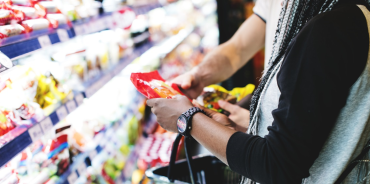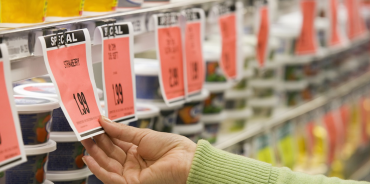Why making the most of holidays and events means putting the Customer first
From Halloween to the Superbowl, Christmas to Diwali, holidays, festivals, and seasonal events can have a dramatic effect on our shopping behaviours. Whether we’re hosting a gathering, buying gifts, or just enjoying the celebrations, our grocery requirements are often vastly different – old habits supplemented with new needs and expectations.
At times like these, it’s never more important for Retailers and Brands to put the Customer first. While holidays and events might present a huge commercial opportunity – 73% of Retailers expect shoppers to spend more this holiday season than they did last[1] – they also offer an unrivalled chance to do more, and be more, for shoppers. Communication is vital, and whether it’s helping them build their lists, discover new products, or seek out value, Retailers and Brands must deliver help and inspiration where Customers need it most.
Realising that opportunity, of course, means understanding exactly what it is that Customers actually want. Shopping missions don’t disappear during holidays and events, and the fact that it’s Christmas or Back to School doesn’t change the fact that we still need to grab lunch, or pick up an item that we forgot during our weekly shop. What’s different is that we might now be doing so at the same time that we’re planning a party or shopping for stationery. Context is everything.
Truly putting the Customer first during these moments means asking the questions that help us make sense of that context. The answers we get can inform everything from basic segmentations to very specific insights, but each provides an additional level of nuance that helps us build a detailed picture of every shopper.
Amongst other things, we need to understand:
- Which Customers we should communicate to about which holidays or events
- How their needs might change during this time
- What missions they’re looking to achieve, and what defines success for them
- Which channels are most relevant for which Customers and which products
- How we can communicate with them in a way that’s as additive and useful as possible
- Which engagement tactics have been employed before, and how effective they were
- How we should define success for the Customer, the Retailer, and for Brands
By asking – and answering – these questions, we can begin to ensure that event and holiday-based communications are genuinely tailored to individual Customers. And, needless to say, that offers benefits for everyone involved.
Brands get the opportunity to engage with Customers at a more emotional level
Typically, the only dialogue that Brands have with shoppers in a Grocery Retail environment will be around price. Advertising and marketing initiatives outside the store play a role in shopper choice, of course, but the “conversation” at the shelf largely comes down to cost.
Retail Media has changed that relationship, providing Brands with the ability to communicate their value in new ways. During events and holidays, when Customers may have different, or entirely novel needs, data-driven, insightful Retail Media campaigns can go further still, delivering additive and helpful communications that enable shoppers to make better-informed decisions. When those campaigns are activated in partnership with the Retailer, that effect grows stronger still – crucial when we consider that around 90% of Customers want to shop at stores that make it easier or more efficient to buy groceries during the holidays[2].
Not only does this make for a more compelling and engaging interaction with Customers, it also helps Brands meet multiple marketing objectives at once. In comparison to a standard trade activation, a tailored and relevant event-based campaign can drive everything from awareness to sales. And when more Customers are already spending more, more often, that’s a hugely compelling proposition.
Retailers can create meaningful moments that drive genuine differentiation
Holidays and events hold huge potential for Retailers, particularly when they collaborate closely with their Brand partners. Just as the above example promises to help Brands elevate their conversation with shoppers, it can also help to differentiate the Retailer – showing that they have a genuine appreciation of the Customer and their needs. Combine that with an extra incentive (exclusive items or lines that are yet to hit the wider market, say) and shoppers have an even greater reason to visit.
As well as generating advertising revenues for the Retailer, insights-driven, collaborative campaigns have the additional benefit of helping to maintain consistency of message. At a time when the industry as a whole can be shouting just to be heard, that can bring some much needed clarity and simplicity to the equation.
Both parties can work together to deliver a better-connected experience
Data-driven collaboration isn’t solely about the message; it can also aid from a planning perspective, too. When Retailers and Brands have a combined understanding of shoppers and how they behave, they can better anticipate everything from timings to stock levels.
Christmas presents a perfect example of why this is needed. Some Customers will begin preparing weeks – or even months – in advance, with little concern about what they’re spending; this year, around a quarter of US shoppers started buying gifts before the end of September, for instance[3].
Others may need to wait until just a few days before, and adhere to a strict budget. Knowing how Customers shop for a holiday like this helps us communicate to them at the right time, send promotions and offers when they really need them, and ensure that the right products are there to greet them, too.
Better insights also help us to ensure that key Customer segments aren’t missed during planning. The focus during Back to School might ordinarily be on helping parents get what their children need for the new term, but the baskets of teachers will change fundamentally during this time too. With deeper understanding comes the ability to ensure that no-one’s needs end up neglected.
Customers enjoy a more personalised and shopping experience
Ultimately, it all comes down to this. As tempting as it can be to focus on the sales opportunity inherent in holidays and events, nothing matters more than being able to create better, more relevant, and more helpful shopping experiences for Customers when they’re busy.
Holidays and events can be a genuine win-win-win: a win for Retailers, and a win for Brands – but only if we make them a win for Customers first.
[1] Holiday Retail Survey – Deloitte, 2021
[2] The State of Grocery Retail Report – Phononic, November 2018
[3] Here’s what could mess up your holiday shopping this year — and why you should start early – CNBC, September 2021
RELATED PRODUCTS
Amplify Customer understanding to create strategies that drive results
Customer First solutionsThe latest insights from our experts around the world
AI-powered, personalised loyalty: the next frontier in the pursuit of customer relevance
Six ways in which New Zealand’s suppliers can strike the balance between pricing and promotion




